Plumbing in the country itself
Today it is already difficult to see a man who raises water from a well by hand. Many site owners are trying to make a plumbing system. The same applies to the garden. Here, on a plot that is intended for growing vegetables and garden trees, water is the most necessary resource. That is why many people are interested in how to conduct water supply in the country with their own hands. This will be discussed in this article.
Stages of creation

Before you begin the installation of water supply at your dacha, it is necessary to carry out some preparatory work. First, determine the source of water. Secondly, make a diagram of the location of all elements of the water supply system.
Tip! It is worth considering how long you will need water. Winter and summer water supply will differ both in materials used and in their design.
And of course, do not forget about the pipes used. In this regard, modern manufacturers can offer two proven options:
- metal pipes;
- plastic products.

More recently, except for steel pipes, there was nothing to use. But such material does not differ in durability. The metal is corroded and the plumbing system quickly fails. In addition, to mount such communications is quite difficult. Another thing - plastic pipes. They are lightweight, inexpensive and do not corrode. All this made plastic products very popular.
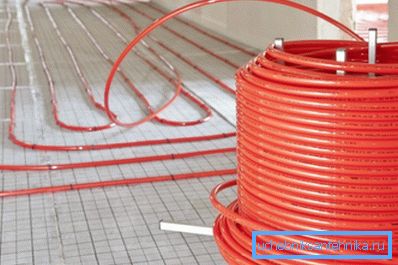
If you use the water supply only in the summer period and only for watering the vegetable garden, then hoses can be used instead of pipes. In this case, suitable as a normal garden option, and fire hoses. Only such a system can hardly be called plumbing.
Where to get water

First of all, before planning your water pipeline at the dacha, it is important to determine the source of water. For these purposes, you can use several options. For example, take water from:
- well;
- open source;
- wells;
- central water supply systems.
Each option has its advantages and disadvantages. Let's start with the last - the central water supply. In this case, you do not need to worry about buying a pump (of course, if the pressure in the system is sufficient). In addition, in the central water supply is already purified water, which means that there is no need to install filters.
But this option is not always acceptable. Firstly, not all holiday villages have a central water supply. Secondly, for the use of such a system you have to pay. The more water you use for irrigation or personal needs, the greater the cost.
Tip! Using water from an open source is not always possible. Not every stretch of river or lake. In addition, to use them, you must obtain permission. Another disadvantage is the purity of the water. Of course, such a “liquid” is quite suitable for irrigation, but it is better not to use it as drinking water.

The well is the easiest option. Here and the water is clean enough (but still, to use it for drinking or cooking, you need to install filters), and get it easier. The downside is the well itself. It can not dig up everywhere. For example, in areas where the underground aquifer is located too deep (20 meters or more), it will be difficult to dig a well, and, most likely, impossible.
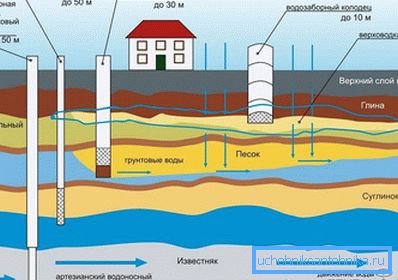
The most optimal source of water can be considered an artesian well. True, it is necessary to invest in its creation. First, it is necessary to invite specialists who will determine where the water layer lies. Secondly, it is necessary to buy pipes and pay drillers for the well itself. But as a result, you will have your own uninterrupted source of clean water. It is enough for you and for watering, and for drinking and cooking, and for technical and domestic needs. In addition, your operating expenses will consist only of electricity bills.
What is better pump or pumping station
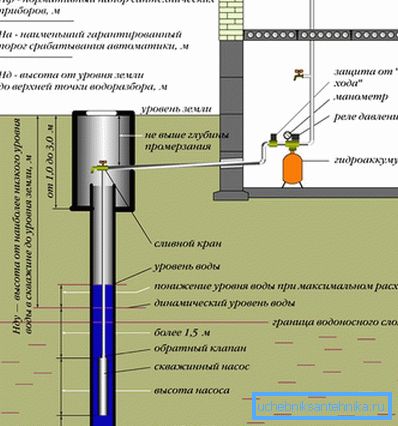
If you have understood the source of water, then you should think about how to get it from there. To plumbing in the country worked as it should, you need to use additional equipment. So, for pumping water from a well you can use:
- deep well pump;
- surface pump;
- pump station.
The first option is considered the most common. Submersible pumps are placed directly into the well. Such units are able to pump out water from a depth of 10 to 150 meters.
To install a submersible pump, the pipe in the well must correspond to the cross section of the unit itself. This requires more drilling costs than using, for example, a pumping station. Before the pump is lowered into the well, an electrical cable is connected to it, a water pipe (most often made of polymeric materials) and a cable on which the device will hold. Then the unit is lowered into the pipe to the level of groundwater.
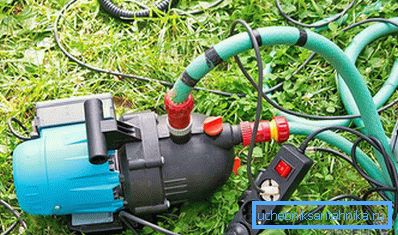
Surface pumps are installed in the event that the depth of the water is not more than 10 meters. Such units for the suburban water supply system are often used if the source of water is an open water body. It is enough to install the pump on the bank of the river or lake, lower the suction hose with a net into the pond, and turn it on.
Tip! Unlike deep-well pumps, surface pumps can work not only with electric power, but also with liquid fuel. But diesel and petrol units are mainly used during watering. For constant operation of the plumbing system, such devices are unsuitable because of the need to constantly add fuel to the tank.
Not so long ago pump stations appeared on the market. The set of such a device, in addition to the pump, includes a water tank, a suction hose, and various automatics.
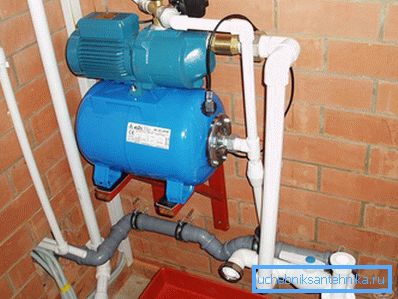
Pumping stations differ in the presence and location of the ejector:
- built in. Such units are considered the most powerful. The station with a built-in ejector is capable of pumping out water from a well up to 40 meters deep. The only drawback of such a device is its high noise level;
- external. In this case, the ejector is located on the intake hose and is lowered directly into the well. Such devices can also pump water from a depth of 40 meters and, moreover, they work quietly. The disadvantage of pumping stations with an external ejector is their sensitivity to fine solid particles that can get into the water from the well;
Without an ejector. Such pumping stations are the cheapest. They can pump out water only from a depth of up to 10 meters. But they are economical and silent.
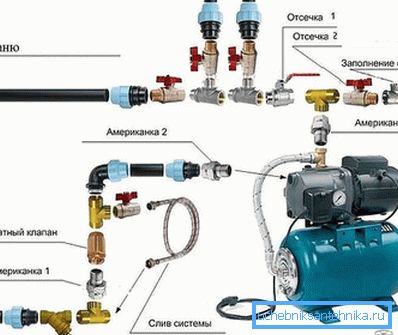
Tip! The advantages of pumping stations compared to simple pumps are that they operate autonomously. In addition, due to the presence of a tank (accumulator), water can still be used for some time after a power outage. That is why many people choose pumping stations, if the water supply system at the dacha is needed not only for irrigation, but also for domestic needs.
The difference of the summer water supply from the winter
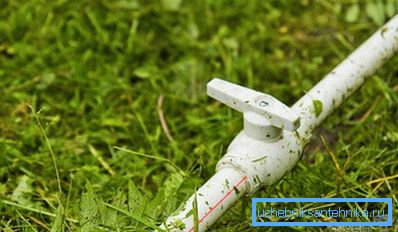
Plumbing in the country need to achieve two goals. First of all, it is necessary for supplying water to the house for domestic needs and drinking. But, besides this, many gardeners grow vegetables, roots and garden plants on their plots. And all living organisms need water, and in large quantities.
If your cottage serves only for growing plants, then it makes no sense to hold a winter water supply. Summer option is much cheaper. It will require less effort during installation. How to make a summer water supply will depend on its varieties. Here you can try to mount two options:
- temporary;
- stationary.

In the first case, you just need to install a pump, connect hoses to it, and your water supply is ready. After the end of the irrigation season, all elements of the system are simply removed into a warm room or garage.
If you do not want to mess around each time with stretching and shifting hoses from place to place, then you can make a stationary water supply system for watering plants. In this case, it is enough to lay several pipes along all the plantations and equip them with stop valves.
If watering is necessary, you turn on the pump and open the desired valve. Water enters the beds and irrigates them. After the end of the season, it is enough to simply remove the pump in a warm room and remove any remaining water from the pipes.
If the water supply system should work during the winter period, then great efforts should be made to create it. This is due to the fact that all elements need insulation.
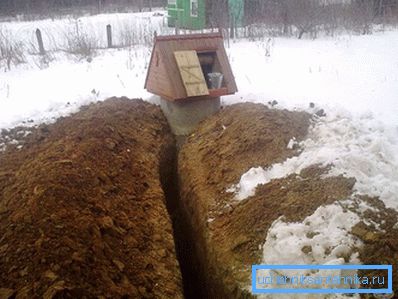
As a rule, so that the pipes do not freeze during the winter cold, they are laid to a depth below the ground freezing level. But in some regions, this figure can be equal to one and a half or even two meters. Not everyone can dig such deep trenches in the country.
There is another, easier way. In this case, the depth of laying the pipes will be no more than half a meter. But it is impossible to bury a trench just like that, communications will necessarily freeze over. To prevent this, use insulation. As such, you can apply;
- slag;
- expanded clay;
- foam chips, etc.
The heater you have chosen must have certain characteristics. First, he should not be afraid of dampness and aggressive environments. Secondly, the material should “dislike” various rodents and other small animals. In addition, the insulation should not be suitable for living mold fungi.
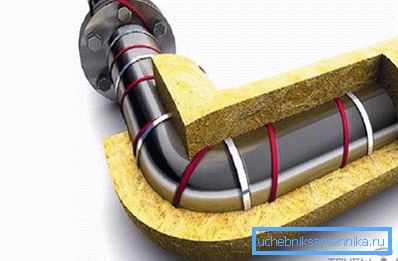
Today, special covers (shells) for water supply systems have appeared on the market. They can be of different diameters and neatly worn on the pipe. This insulation is made of various polymers, has a small thickness and a low coefficient of thermal conductivity. The use of such covers significantly facilitates the work on the installation of water supply in the country. Indeed, in this case, it is enough to deepen the pipes into the ground by only 20–30 cm.
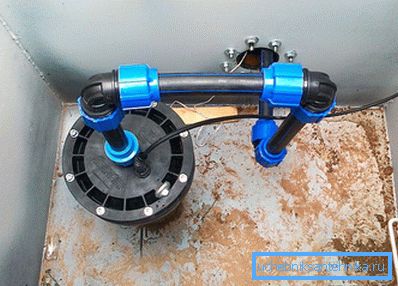
But not only communications need warming. Your well and pump (or pumping station) also need to be protected from freezing. For these purposes, most often used caisson. This design is a container located above the well with a pump. The caisson is also insulated with heat insulating materials.
Video
An overview of the suburban water supply system is shown in the video:
See also:
- How to bump into the plumbing under pressure.
- Insulation of water pipes.
- Water pipes are buzzing: what to do.
- Defrost the water pipe.